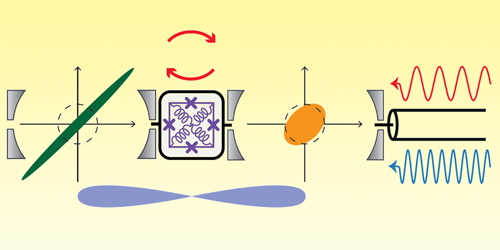Microwave Squeezing Beyond 3 dB
For most quantum physics applications, dissipative interactions—those that occur between a quantum system and its environment—are the enemy, as they can ruin delicate and carefully prepared quantum states. Now, Benjamin Huard, at the École Normale Supérieure in Lyon, France, and colleagues have used the phenomenon to their advantage, employing “dissipation engineering” to “squeeze” microwave light in a cavity to an unprecedented level. The technique could allow for faster readout of qubits in a superconducting quantum computer and, eventually, for the sharing of entangled states across quantum networks.
Quantum fluctuations constrain how precisely researchers can measure certain pairs of properties of a light wave, such as the amplitude and phase of its electric field. The uncertainty in one property can be reduced to a level below that of quantum fluctuations at the cost of a greater uncertainty in the other property, a process known as quantum squeezing. For propagating light waves, there is no bound on this uncertainty reduction, but for light in a cavity, the reduction has a threshold known as the 3 dB limit.
Huard and his colleagues show that they could surpass this limit by “pre-squeezing” the light before it enters the cavity. To do that, the team coupled their cavity to a second, highly dissipative “dump” cavity via a nonlinear device called a Josephson ring modulator (JRM). Pumping the JRM with two microwave tones with different frequencies generated an exchange between the two cavities that caused the dump cavity to input already-squeezed light into the cavity of interest. The approximately 8 dB of squeezing that they achieved using this process is a record for a microwave cavity.
–Marric Stephens
Marric Stephens is a Corresponding Editor for Physics Magazine based in Bristol, UK.
References
- R. Dassonneville et al., “Dissipative stabilization of squeezing beyond 3 dB in a microwave mode,” PRX Quantum 2, 020323 (2021).




